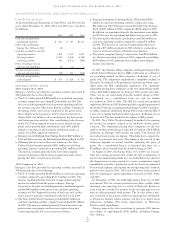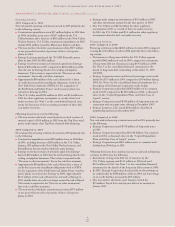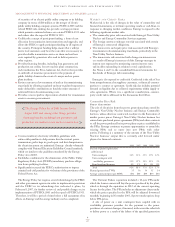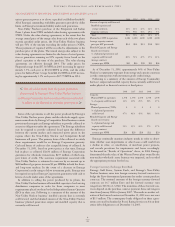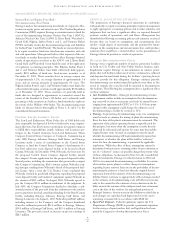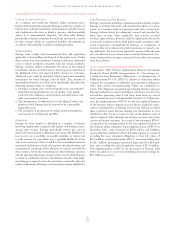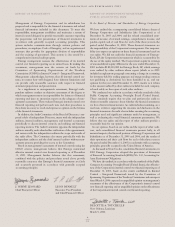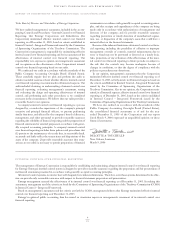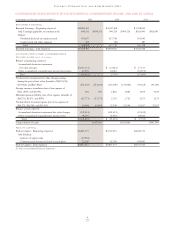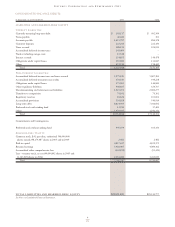Entergy 2005 Annual Report Download - page 55
Download and view the complete annual report
Please find page 55 of the 2005 Entergy annual report below. You can navigate through the pages in the report by either clicking on the pages listed below, or by using the keyword search tool below to find specific information within the annual report.
ENTERGY CORPORATION AND SUBSIDIARIES 2005
*
51
require that the sum of the expected undiscounted future cash flows
from the asset be compared to the asset’s carrying value. If the
expected undiscounted future cash flows exceed the carrying value,
no impairment is recorded; if such cash flows are less than the
carrying value, Entergy is required to record an impairment charge
to write the asset down to its fair value. If an asset is held for sale, an
impairment is required to be recognized if the fair value (less costs
to sell) of the asset is less than its carrying value.
These estimates are based on a number of key assumptions,
including:
■Future power and fuel prices – Electricity and gas prices have
been very volatile in recent years, and this volatility is expected
to continue. This volatility necessarily increases the imprecision
inherent in the long-term forecasts of commodity prices that are
a key determinant of estimated future cash flows. There is cur-
rently an oversupply of electricity throughout the U.S., includ-
ing much of Entergy’s service territory, and it is necessary to
project economic growth and other macroeconomic factors in
order to project when this oversupply will cease and prices will
rise. Similarly, gas prices have been volatile as a result of recent
fluctuations in both supply and demand, and projecting future
trends in these prices is difficult.
■Market value of generation assets – Valuing assets held for sale
requires estimating the current market value of generation
assets. While market transactions provide evidence for this
valuation, the market for such assets is volatile and the value of
individual assets is impacted by factors unique to those assets.
■Future operating costs – Entergy assumes relatively minor annual
increases in operating costs. Technological or regulatory
changes that have a significant impact on operations could cause
a significant change in these assumptions.
In the fourth quarter of 2005, Entergy recorded a charge of
$39.8 million ($25.8 million net-of-tax) as a result of the impairment
of the Competitive Retail Services business’ information technology
systems. Entergy has decided to divest the retail electric portion of
the Competitive Retail Services business operating in the ERCOT
region of Texas and, in connection with that decision, management
evaluated the carrying amount of the Competitive Retail Services
business’ information technology systems and determined that an
impairment provision should be recorded.
In the fourth quarter of 2004, Entergy recorded a charge of
approximately $55 million ($36 million net-of-tax) as a result of an
impairment of the value of the Warren Power plant. Entergy con-
cluded that the value of the plant, which is owned in the non-nuclear
wholesale assets business, was impaired. Entergy reached this
conclusion based on valuation studies prepared in connection with
the Entergy Asset Management stock sale discussed above in
“Results of Operations.”
QUALIFIED PENSION AND OTHER
POSTRETIREMENT BENEFITS
Entergy sponsors qualified, defined benefit pension plans which
cover substantially all employees. Additionally, Entergy currently
provides postretirement health care and life insurance benefits for
substantially all employees who reach retirement age while still
working for Entergy. Entergy’s reported costs of providing these
benefits, as described in Note 10 to the consolidated financial state-
ments, are impacted by numerous factors including the provisions of
the plans, changing employee demographics, and various actuarial
calculations, assumptions, and accounting mechanisms. Because of
the complexity of these calculations, the long-term nature of these
obligations, and the importance of the assumptions utilized,
Entergy’s estimate of these costs is a critical accounting estimate for
the U.S. Utility and Non-Utility Nuclear segments.
Assumptions
Key actuarial assumptions utilized in determining these costs include:
■Discount rates used in determining the future benefit
obligations;
■Projected health care cost trend rates;
■Expected long-term rate of return on plan assets; and
■Rate of increase in future compensation levels.
Entergy reviews these assumptions on an annual basis and adjusts
them as necessary. The falling interest rate environment and worse-
than-expected performance of the financial equity markets over the
past several years have impacted Entergy’s funding and reported
costs for these benefits. In addition, these trends have caused
Entergy to make a number of adjustments to its assumptions.
In selecting an assumed discount rate to calculate benefit obliga-
tions, Entergy reviews market yields on high-quality corporate debt
and matches these rates with Entergy’s projected stream of benefit
payments. Based on recent market trends, Entergy reduced its dis-
count rate used to calculate benefit obligations from 6.25% in 2003
to 6.00% in 2004 and to 5.90% in 2005. Entergy reviews actual
recent cost trends and projected future trends in establishing health
care cost trend rates. Based on this review, Entergy increased its
health care cost trend rate assumption used in calculating the
December 31, 2005 accumulated postretirement benefit obligation
to a 12% increase in health care costs in 2006 gradually decreasing
each successive year, until it reaches a 4.5% annual increase in
health care costs in 2012 and beyond.
In determining its expected long-term rate of return on plan
assets, Entergy reviews past long-term performance, asset alloca-
tions, and long-term inflation assumptions. Entergy targets an asset
allocation for its pension plan assets of roughly 65% equity securi-
ties, 31% fixed-income securities and 4% other investments. The
target allocation for Entergy’s other postretirement benefit assets is
51% equity securities and 49% fixed-income securities. Based on
recent market trends, Entergy reduced its expected long-term rate
of return on plan assets used to calculate benefit obligations from
8.75% for 2003 to 8.5% in 2004 and 2005. The assumed rate of
increase in future compensation levels used to calculate benefit obli-
gations was 3.25% in 2003, 2004, and 2005.
MANAGEMENT’S FINANCIAL DISCUSSION and ANALYSIS continued
Electricity and gas prices have been
very volatile in recent years, and
this volatility is expected to continue.
<
>


